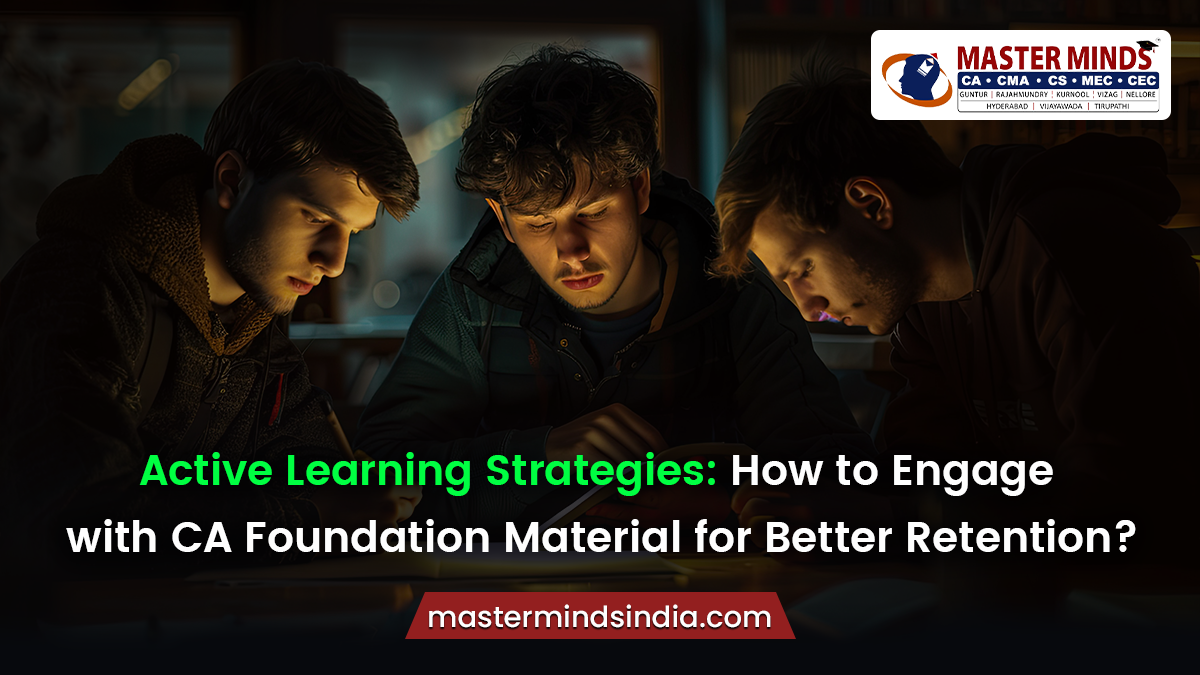Active Learning Strategies: How to Engage with CA Foundation Material for Better Retention?

Studying for the CA Foundation exam isn’t just about working hard—it’s about using the right methods. Active learning can improve memory by up to 60%, making a huge difference in your results. Simply reading books or watching videos isn’t enough; you need smart techniques like testing yourself, explaining topics to others, and using real-life examples to truly understand and remember concepts. In this guide, we’ll share simple but effective strategies to help you study better and retain information for longer.
Ignite Your Curiosity
One of the most effective techniques for active learning is to question everything. Instead of merely reading through your textbooks or notes, pause and ask questions about the material. For instance:
- What is the underlying principle behind this concept?
- How does this theory apply to real-world scenarios?
- What are the potential implications of this rule in different contexts?
By consistently questioning, you foster a deeper understanding and create a mental framework that makes information more accessible and memorable. It transforms passive reading into an engaging intellectual exercise that reinforces your grasp of the subject.
Condense and Conquer
Summarization is a technique where you distill large amounts of information into concise, understandable summaries. After reading a chapter or a section, take a moment to jot down the key points. This exercise forces you to process and interpret the information, which helps in:
- Clarifying your understanding: Summarizing requires you to sift through the material and identify the most crucial elements.
- Reinforcing memory: By rephrasing the content in your own words, you strengthen your recall ability.
- Creating study aids: These summaries can be used as quick reference guides when revising.
Effective summarization is not just about reducing content but about transforming it into a digestible format that aligns with your cognitive processes.
Mastery Through Explanation
One of the most profound ways to solidify your knowledge is to teach it to someone else. This technique, often referred to as the “Feynman Technique,” is based on the idea that if you can teach a concept simply, you truly understand it. Here’s how you can apply this strategy:
- Explain concepts to peers: Use study groups to explain complex ideas to your classmates.
- Create teaching materials: Develop presentations or teaching aids that simplify the subject matter.
- Self-teach: Record yourself explaining topics and review these recordings to identify areas needing improvement.
Teaching forces you to organize your thoughts and communicate them clearly, which highlights gaps in your understanding and enhances your mastery of the material.
Engage and Organize
Active note-taking involves more than just writing down what you hear or read. It encompasses organizing and synthesizing information in a way that promotes deeper engagement. Consider these techniques:
- Mind Mapping: Create visual diagrams that connect concepts and illustrate relationships.
- Cornell Method: Divide your notes into sections for main ideas, key points, and summaries.
- Charting: Use charts to compare and contrast different theories or approaches.
These methods make your notes interactive and engaging, allowing you to see connections between ideas and facilitating more effective review sessions.
Test Your Knowledge
Retrieval practice is the act of actively recalling information from memory, which strengthens your ability to remember it later. To incorporate retrieval practice:
- Use flashcards: Create flashcards with questions on one side and answers on the other.
- Take practice quizzes: Regularly test yourself on various topics.
- Engage in spaced repetition: Review information at increasing intervals to reinforce long-term retention.
Frequent retrieval helps embed information into your long-term memory and prepares you for the types of questions you’ll encounter on the exam.
You Can Also Read:
- CA Intermediate New Study Material
- CA Course Duration After 10th, 12th & Graduation
- Tips to Crack CA in First Attempt
- Time-Saving Calculator Tricks for CA Foundation Students
- How to become a CA?
- CA Foundation New Syllabus
- CA Inter New Syllabus
- ICAI CA New Scheme
Connect Theory with Practice
Applying theoretical knowledge to practical situations bridges the gap between academic concepts and real-world applications. Engage in:
- Case Studies: Analyze real-life cases related to your syllabus and apply your knowledge to solve them.
- Simulations: Use online simulations or exercises that mimic real-world scenarios.
- Internships: Seek internships or practical experiences where you can apply theoretical knowledge in a professional setting.
By connecting theory with practice, you gain a more comprehensive understanding and appreciation of how your studies apply beyond the classroom.
Evaluate and Adjust
Reflection involves assessing your learning process and adjusting strategies as needed. After each study session:
- Evaluate your understanding: Reflect on what you’ve learned and identify areas needing more focus.
- Adjust your methods: Modify your study techniques based on what’s working and what isn’t.
- Set goals: Create actionable goals for future study sessions based on your reflections.
Reflection ensures that your learning process remains dynamic and tailored to your evolving needs.
CA & CMA Online Classes:

